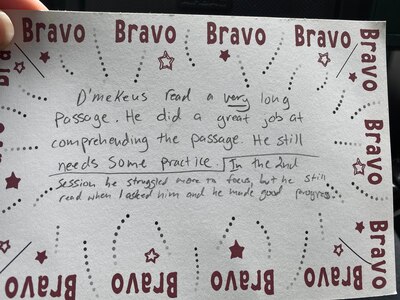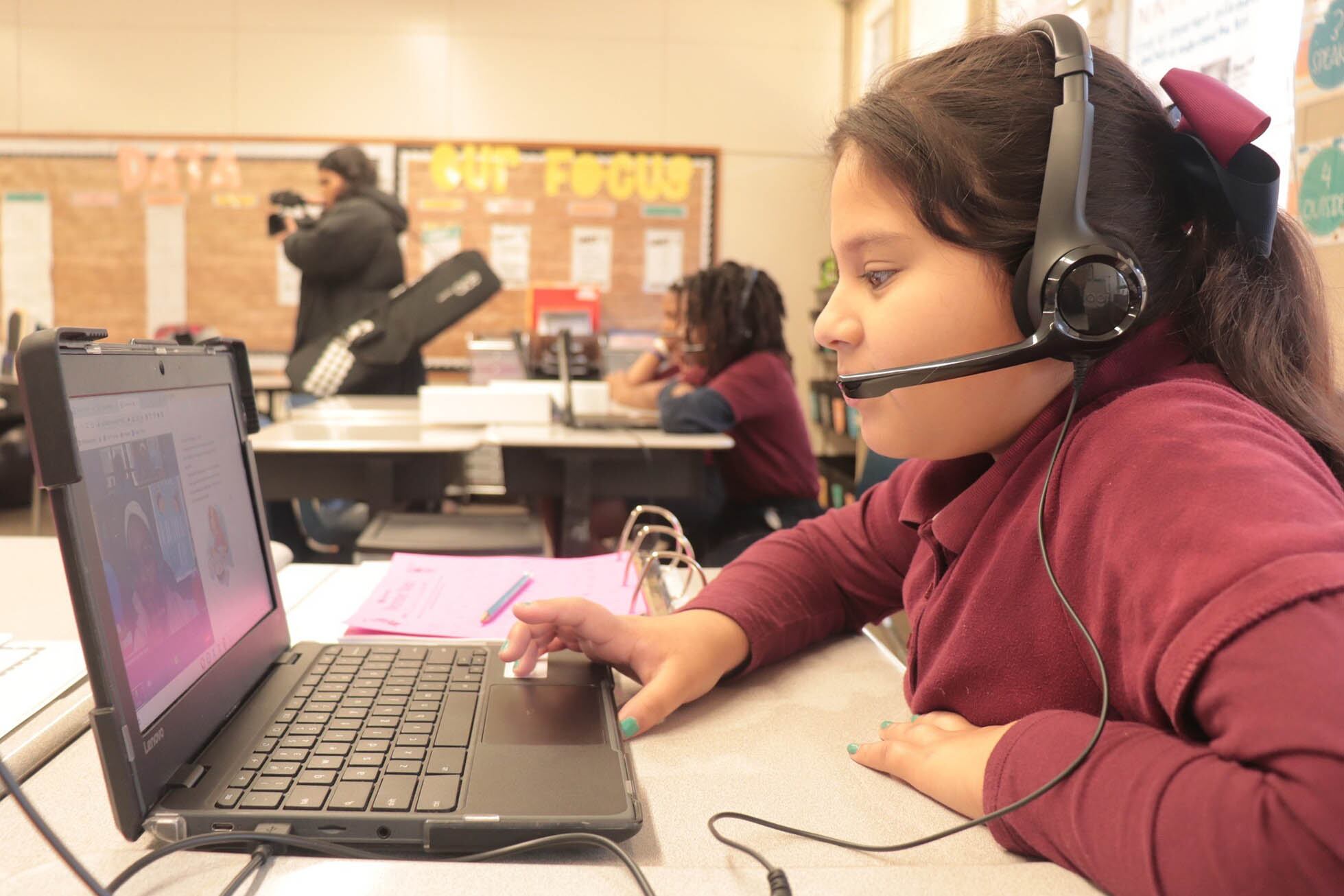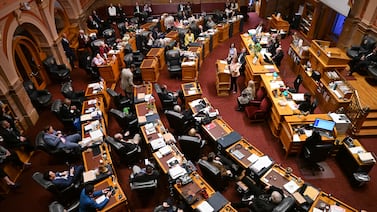Sign up for Chalkbeat’s free weekly newsletter to keep up with how education is changing across the U.S.
As Kelli Bottger works on tutoring programs across Louisiana, she’s been taking state lawmakers on tours, hoping they’ll see what she sees: Tutoring works.
On a visit to an elementary school in East Baton Rouge Parish this past fall, lawmakers took note of how close students had gotten to their tutors. Those relationships had even motivated kids who’d missed a lot of school to attend more regularly.
“It’s one thing for us to explain tutoring, it’s another thing to see it in practice,” said Bottger, who directs the Louisiana Kids Matter Campaign. The organization is piloting reading and math tutoring as part of a $2 million initiative funded by the state and the national nonprofit Accelerate. “They liked the one-on-one attention they were getting with their tutor. They liked being heard and listened to.”
Federal pandemic aid paid for a major expansion of tutoring across the U.S. As the money runs out, education officials and advocates are pushing for state legislators and schools to find a way to keep these programs going. There’s widespread agreement that lots of kids still need academic help, and schools need to provide it.
But the big question is: Where will the money come from?
State lawmakers have lots of funding requests on their plates right now, and not just from schools. Even if some states do come through with extra funds, it will likely be less than what schools had to work with before. That’s left school leaders scrambling to find alternative funding sources and poring over their budgets to figure out what can go so tutoring can stay.
“There is a lot of conversation about what strategic investments districts need to be making, and what should be prioritized,” said Nakia Towns, the chief operating officer for Accelerate, which funds and researches tutoring efforts. “High-dosage tutoring has such an incredible payoff for kids,” she said, that it should be “right at the top of that list.”
Why some states may keep spending on tutoring
Forty states have spent money on tutoring since the pandemic began, according to a recent review conducted by the National Student Support Accelerator, a Stanford University program that researches tutoring.
That’s added up to a huge investment. Last year, the nonprofit Council of Chief State School Officers, which represents state education department heads, estimated that states would spend $700 million of their federal COVID relief dollars to expand tutoring efforts. And local school districts are expected to spend more than $3 billion of their own COVID aid on tutoring, according to an estimate from the Georgetown University think tank FutureEd, based on data compiled by the company Burbio.
Many states also worked to ensure the quality of those tutoring programs. The Stanford review found that 26 states set ground rules so that schools would follow tutoring best practices, such as keeping groups small and holding sessions several times per week. Some say after states did all that legwork, it makes sense not to walk away now.
Already, some states have pledged continued funding — and federal officials have indicated they’d look favorably on state requests for more time to spend pandemic aid if it’s going toward tutoring.
Virginia put an extra $418 million in its state budget for academic recovery this past fall, and plans to spend 70% of that on high-dosage tutoring for students who failed or received low marks on state tests. Michigan set aside $150 million in state funds last year for intensive tutoring under the state’s MI Kids Back on Track program.
Others are working on it. Some Texas districts have asked the state to continue funding tutoring.
In Louisiana, Bottger and State Superintendent Cade Brumley are hopeful the legislature will sign off on putting money for in-school tutoring into the state’s main funding stream for schools. How much money that could be is still under discussion. But it would be in addition to the $5 million request the education department made to add math to the state’s $40 million literacy tutoring voucher program.
As Brumley meets with state officials to talk about more money for tutoring, his message has been: “Please give it serious consideration.”
“Students need to be able to read and do math by the time they exit our elementary schools,” he said.
In New Jersey, Paula White, the executive director of the advocacy group JerseyCAN, is asking the state to keep paying for tutoring, too.
As White tries to win lawmakers’ continued support, her plan is to emphasize the positive results that tutoring has produced and the state’s stagnant test scores — “Are we over the hump? Is the problem solved? And we know the answer to that is ‘no,’” she said.
It helps, she said, that state leaders have already talked publicly about the importance of tutoring, as New Jersey is running a $52 million high-impact tutoring grant program with federal funds. Still, she knows it will be an “uphill battle” with other federal aid drying up, and the state taking in less revenue.
“We just have to be vigilant about making sure that it gets the budgetary attention that it deserves,” White said.
How school districts are trying to fund tutoring themselves
Absent new state funds, many districts will likely be looking for programs to trim or eliminate so they can keep tutoring. That’s what Superintendent Scott Muri and his team are doing now in Ector County, Texas.
During the pandemic, the district launched a virtual tutoring program that’s become a must-keep. Ector County schools budgeted around $5 million a year in COVID funds for the program, which amounts to 1% of the district’s discretionary spending. Now staff are hoping to make up part of the difference by cutting math and reading apps that aren’t working well, or aren’t used much. In the past, teachers or schools could pick their preferred programs, but that resulted in a lot of duplication.
“Choice and options are still important, but we want the most effective options,” Muri said. “Let’s get rid of the good and only keep the great.”
Districts also will be looking for ways they could spend existing federal or state funding meant to help students from low-income families, students with disabilities, or English learners on tutoring programs. States could help by providing school districts with more guidance on how they can combine those pots of money, said Allison Socol, a vice president at The Education Trust, which recently published a guide for making equitable budget decisions as COVID aid runs out.
“One of the things we’ve heard directly from district leaders and school leaders is struggles with rethinking how those dollars are spent,” Socol said. “Status quo is hard to change.”
Some may consider shrinking the size of their tutoring program to focus on kids who most need help, or cutting an after-school tutoring program to focus on tutoring during the school day. That’s considered a better way to reach students, as many kids don’t have transportation or can’t stay after school.
However, tutoring experts are cautioning against making group sizes larger or reducing how often tutoring happens as a way to cut costs.
“Once a week in a small group of 10″ isn’t likely to produce “the outsized positive effects that we expect from high-impact tutoring,” said Nancy Waymack, who directs research partnerships and policy for the National Student Support Accelerator. “We really want to make sure that those groups are kept to a small number, so that students can get individual attention.”
There could be other avenues, too. Some school districts and tutoring programs have used federal work study grants to pay college students to tutor, according to a January report from FutureEd. Federal officials are urging schools to tap that funding source, though it can be a little complicated.
Amy Cohen, an assistant vice provost at the George Washington University, helps recruit and train college students to tutor middle schoolers in DC Public Schools. They’re paid using federal work-study funds through a program called Math Matters.
The college students take a one-credit course to learn about the curriculum they’ll use and how to work with kids, and then Math Matters matches them with schools that want tutors. So far, it’s been a popular work-study job, and the program has placed 84 tutors in schools.
With 30 years of experience working on work-study programs, Cohen says there are a few things to keep in mind.
It’s relatively easy for a college to launch a new work-study job like this, but it can be harder for a school district to know where to start. A staff person who can handle recruitment and oversight is key, Cohen said — but that’s an added cost.
And tutoring sessions backed by work-study dollars have to be planned carefully so college students don’t hit their earning limit too quickly, which would create inconsistency for kids.
“Federal work study is a hugely important and sometimes overlooked asset,” Cohen said. “I really hope that more investment is made in both thinking about how to do it well and in offering supports.”
Parents see benefit of funding tutoring long term
In the meantime, parents like Kezne’ Cook and D’Mekeus Cook of Lafayette, Louisiana would like to see states continue to fund tutoring programs like the one that’s helped their fourth grader over the last two years.

Their son, who’s also named D’Mekeus, spent part of kindergarten and all of first grade learning remotely during the pandemic. When he entered second grade, his mom could tell he was struggling to understand what they were reading in class, and he no longer wanted to read aloud at school.
The family took D’Mekeus to a tutoring center after school to get extra help, but that started to get pricey. So they were relieved when they found out about the state’s tutoring voucher program, which provides families with $1,000 per eligible child to pay for private tutoring.
As D’Mekeus got more one-on-one help, his dad noticed his son’s confidence returned, and he started doing better in other subjects at school, too. It’s important for programs like this to stick around, the Cooks said, because it takes time for kids to make progress.
“It’s not something that just occurs overnight,” said Kezne’ Cook. “I see the steps it takes to get to where he’s at now.”
Kalyn Belsha is a senior national education reporter based in Chicago. Contact her at kbelsha@chalkbeat.org.







